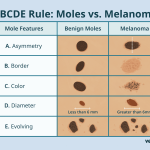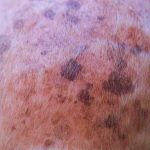A small, harmless-looking spot on your skin can either be a benign mole or a malignant melanoma – two vastly different entities with life-altering consequences.
The Importance of Identifying the Difference
When it comes to moles, most people think they’re just pesky little blemishes that don’t warrant much attention. But the reality is that some moles can be a sign of something far more sinister lurking beneath the surface.
The Consequences of Ignoring Mole Development
According to the American Cancer Society, melanoma – the most aggressive and deadly form of skin cancer – claims over 10,000 lives annually in the United States alone. And while early detection is key to successful treatment, many cases go undiagnosed until it’s too late.
Benign Mole: A Non-Cancerous Entity
A benign mole is a non-cancerous growth that can appear anywhere on the skin. Characterized by uniform pigmentation and smooth edges, these moles are often harmless and may even fade or disappear over time.
A small, harmless-looking spot on your skin can either be a benign mole or a malignant melanoma – two vastly different entities with life-altering consequences.
The Importance of Identifying the Difference
When it comes to moles, most people think they’re just pesky little blemishes that don’t warrant much attention. But the reality is that some moles can be a sign of something far more sinister lurking beneath the surface.
The Consequences of Ignoring Mole Development
According to the American Cancer Society, melanoma – the most aggressive and deadly form of skin cancer – claims over 10,000 lives annually in the United States alone. And while early detection is key to successful treatment, many cases go undiagnosed until it’s too late.
Benign Mole: A Non-Cancerous Entity
A benign mole is a non-cancerous growth that can appear anywhere on the skin. Characterized by uniform pigmentation and smooth edges, these moles are often harmless and may even fade or disappear over time.
Common Characteristics of Benign Moles
Benign moles typically exhibit certain characteristics, including:
- Uniform coloration: Benign moles tend to have a consistent shade throughout, ranging from light brown to dark brown.
- Symmetrical shape: Benign moles are often symmetrical in shape, with edges that blend smoothly into the surrounding skin.
- Stable size: Benign moles usually remain stable in terms of size and shape over time, without growing or changing significantly.
Malignant Mole: A Cancerous Entity
A malignant mole, on the other hand, is a cancerous growth that can be life-threatening if left untreated. Characterized by irregular pigmentation, jagged edges, and rapid growth, these moles are a sign of melanoma – a type of skin cancer.
Common Characteristics of Malignant Moles
Malignant moles typically exhibit certain characteristics, including:
- Irregular coloration: Malignant moles often display uneven or patchy pigmentation, with shades ranging from red to dark brown.
- Jagged edges: Malignant moles tend to have rough, irregular edges that may bleed or ooze fluid.
- Rapid growth: Malignant moles can grow rapidly and may change shape or size over a short period of time.
The Key to Identifying the Difference
So, how do you tell benign from malignant? The answer lies in a combination of factors, including:
- A thorough physical examination: A dermatologist can examine your mole and surrounding skin to look for any signs of irregularity or abnormal growth.
- A history of changes: Keeping track of any changes in the size, shape, color, or bleeding of your mole is crucial in detecting potential issues early on.
Remember, when it comes to moles, it’s always better to err on the side of caution. If you’re unsure about a mole’s nature or have concerns, consult a dermatologist for a professional evaluation. And don’t forget – early detection is key to successful treatment and long-term health.
Learn more about melanoma risk factors and how you can reduce your risk of developing this aggressive form of skin cancer.
Get Expert Advice on Skin Health
Stay informed about skin cancer and take control of your health.
Consult an ExpertA small, harmless-looking spot on your skin can either be a benign mole or a malignant melanoma – two vastly different entities with life-altering consequences.
The Importance of Identifying the Difference
When it comes to moles, most people think they’re just pesky little blemishes that don’t warrant much attention. But the reality is that some moles can be a sign of something far more sinister lurking beneath the surface.
The Consequences of Ignoring Mole Development
According to the American Cancer Society, melanoma – the most aggressive and deadly form of skin cancer – claims over 10,000 lives annually in the United States alone. And while early detection is key to successful treatment, many cases go undiagnosed until it’s too late.
Benign Mole: A Non-Cancerous Entity
A benign mole is a non-cancerous growth that can appear anywhere on the skin. Characterized by uniform pigmentation and smooth edges, these moles are often harmless and may even fade or disappear over time.
Malignant Melanoma: A Life-Threatening Entity
A malignant melanoma, on the other hand, is a type of skin cancer that spreads quickly and can be deadly if left untreated. Characterized by irregular borders, uneven pigmentation, and rapid growth, this type of mole requires immediate attention from a medical professional.
What’s at Stake?
The difference between benign and malignant moles is not just about aesthetics; it’s about life or death. Ignoring the signs of skin cancer can have devastating consequences, including disfigurement, disability, and even mortality.
A Call to Action
So what can you do? First and foremost, be aware of your body. Regular self-exams are crucial in detecting abnormalities early on. Don’t hesitate to consult a dermatologist if you notice any changes or concerns. And remember, prevention is always better than cure.
A Final Word
The key takeaway from this critical comparison is that when it comes to moles, ignorance is not bliss. Take control of your skin health today and empower yourself with the knowledge to identify benign from malignant moles. Your life depends on it.
The treatment cost of hepatitis C: Hepatitis C is a silent killer, with millions of people around the world affected by this incurable disease. But what’s even more concerning is the hefty price tag that comes with treating it. Are you prepared for the financial burden? Click to learn more about the costs involved.
1 Urine protein: Understanding its significance: Ever wondered what’s lurking in your pee? Urine protein is a crucial indicator of your overall health, and understanding its significance can help you catch potential problems early. But how does it impact your wellbeing? Click to find out!



